Since 1940
September 2023

Since 1940
September 2023
AT SANDHILL WILDLIFE AREA
POWER STRUGGLE
ENERGY EFFICIENT WINDOWS
MEMBER SPOTLIGHT: CEDAR BEE FARMS

You may not realize it, but your home is sitting on a free and renewable supply of energy. A WaterFurnace geothermal comfort system taps into the stored solar energy in your own backyard to provide savings of up to 70% on heating, cooling and hot water. That’s money in the bank and a smart investment in your family’s comfort. Contact your local WaterFurnace dealer today to learn how to tap into your buried treasure.

Arcadia/Mondovi
Water Source Htg & Clg
(715) 833-9001
Beaver Dam/Green Lake Air Care, Inc.

(920) 356-8860
Black River Falls/ Stevens Point Northern Indoor Comfort
(715) 937-2676
Cashton/Sparta
Flock’s Htg & A/C
(608) 269-1500
Chaseburg/Coon Valley Flock’s Htg & A/C
(608) 269-1500

Clintonville/Oshkosh
Van’s Refrigeration
(920) 833-2051
Cornell/New Auburn Water Source Htg & Clg
(715) 833-9001
Dodgeville/Baraboo
Modern Htg & Clg (608) 767-2689
Eau Claire/Osseo Water Source Htg & Clg
(715) 833-9001
Ellsworth/Lake City Comfort By Design (715) 273-3658
Escanaba/Iron Mountain
GPS Htg & Clg
(715) 732-2111
Friendship/Waupon
All Phase Geothermal
(920) 763-2301
Green Bay/Onedia
Van’s Refrigeration
(920) 833-2051
Hudson/Stillwater Comfort By Design
(715) 273-3658
Janesville/Fort Atkinson
Don Martin Htg (608) 758-9882
Madison Black Earth Modern Htg & Clg
(608) 767-2689
Marinette/Peshtigo
GPS Htg & Clg
(715) 732-2111
Menomonie/Bloomer Water Source Htg & Clg
(715) 833-9001
Neillsville/Medford
Northern Indoor Comfort
(715) 937-2676
New Lisbon/Shamrock
Deans Refrig. & Heating
(608) 372-6928
Oconto/Rhinelander
Van’s Refridgeration (920) 833-2051
Osceola/St. Croix Falls
Comfort By Design
(715) 273-3658
Plymouth/Fond du Lac
Advanced Custom Geothermal (920) 894-3999
Prescott/Hastings
Comfort By Design
(715) 273-3658
Richland Center/Viroqua
Strang’s Htg Electric Plmb (608) 647-2855
Siren/Superior Earth Energy Systems (715) 566-0735

Spring Valley/Amery
Comfort By Design (715) 273-3658
Sturgeon Bay/Denmark
Van’s Refrigeration (920) 833-2051
Tomah/Oakdale
Dean’s Refrig. & Heating (608) 372-6928
Wasau/Angtigo Van’s Refrigeration (920) 833-2051
Westby/La Crosse
Flock’s Htg & A/C (608) 654-5522
Wisconsin Rapids/Warens
Northern Indoor Comfort (715) 937-2676
The Wisconsin Energy Cooperative News (Formerly Wisconsin R.E.C. News) has been published monthly and distributed since July 1940 to members of Wisconsin’s non-pro t, consumer-owned rural electric cooperatives. It is available to non-members for $13 per year or $35 for three years. Members pay $6.93 per year.
Published by the Wisconsin Electric Cooperative Association, 222 W. Washington Ave., Ste. 680, Madison, WI 53703.
Steve Freese, president & CEO.
USPS number: 688-480.
Postmaster: please send address changes to Wisconsin Energy Cooperative News, 222 W. Washington Ave., Ste. 680, Madison, WI 53703.
Periodicals postage paid at Sun Prairie, Wis.
Send correspondence to Wisconsin Energy Cooperative News, 222 W. Washington Ave., Ste. 680, Madison, WI 53703. Phone (608) 467-4650.

Web site: www.wecnmagazine.com.
Co-op Members: Please send address changes to your local electric co-op. Contact information can be found on page 18.
Steve Freese WECA president & CEO
Dana Kelroy editor
Mary Erickson associate editor
Julie Lund contributing writer

Ann Bailey graphic designer
Geri Miller advertising consultant
Jennifer Taylor editorial assistant
For advertising opportunities please email geri@weca.coop. The appearance of advertising or events does not constitute an endorsement of the products or services advertised. We reserve the right to refuse advertisers.
Please recycle










Finding our August Symbol, the pencil, was Mary McDonald, a member of Dunn Energy Cooperative. Mary said, “My daughter found this—after she grabbed it out of my hand and declared she wanted to nd it rst!!! She found the pencil on page 24 in the magni ed picture of the covered bridge thru the leaves but on the side of the bridge. Just a note my son didn’t want to nd it because that means school is soon. LOL.”
Now, we challenge you to nd this bison in honor of our cover story. Remember that the symbol can be anywhere and any size. One randomly selected winner will receive a Wisconsin Energy Cooperative News kitchen kit. One entry per household, please, and provide your permanent home or mailing address with your entry. Send entries by September 15.






We talk about it frequently in this magazine. Co-ops are based on the Seven Cooperative Principles. Since we’re in back-to-school mode this month, we’ll talk about Principle #5: Education, Training, and Information.
I’ve always liked the saying, “You’re either green and growing or ripe and rotting,” referring to learning new things, no matter your age. A curious 90-year-old who looks to learn something new has the capacity for growth while a 20-year-old with all the answers may nd themselves in the rotting camp.
Wisconsin’s electric cooperative leaders pride themselves in pushing beyond their comfort zones to learn and grow. An excellent example was the recent Energy Issues Summit held in Eau Claire for said co-op leaders. As expected, topics covered energy issues and pushed co-op directors and sta outside their comfort zones to stay on the cutting edge of energy technologies, co-op business practices and opportunities, and grid reliability.
But they also had a chance for some hands-on learning. Attendees could test electric power tools, including an electric chainsaw; some even took a spin on the electric bicycles on display. After all, they can’t help members navigate these new products or even promote their use without seeing if and how they actually work.
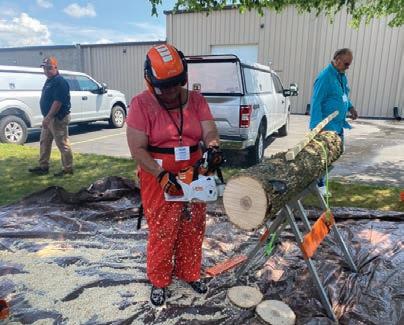

Regardless, whether zipping around on an e-bike or understanding what’s happening in the legislative and regulatory world that will a ect their co-op, like the EPA rule discussed on page 10, you can rest assured that your co-op leaders are continually growing.


 Dana Kelroy Editor
Dana Kelroy Editor













Whether you’re toasting a special occasion, celebrating a holiday, planning a date night, or simply craving an unforgettable meal, getting reservations at your local steakhouse is no easy feat. Luckily for you, we’ve got the insider tip you need to skip the waitlist and get the best seat in the house every time.



Your wallet is going to love this hack as much as your taste buds, because the hottest new steakhouse is in your kitchen and you’re always on the VIP list! Make the everyday extraordinary with a freezer full of world-famous, 100% guaranteed-perfect (or your money back) Omaha Steaks.

With gourmet proteins that are hand-selected and expertly trimmed by master butchers, extra-aged for more flavor and tenderness, and flash-frozen at their most delicious until you’re ready to enjoy, it’s never been a better time to bring the steakhouse home.


U.S. Senator Tammy Baldwin (D-Wisconsin) made a stop at Chippewa Valley Electric Cooperative last month to talk about how federal investments are helping to expand broadband.
Baldwin touted the federal ReConnect Program, which awarded Ntera (created by Chippewa Valley Electric Cooperative and Citizens Connected), more than $3 million in 2020 to expand broadband in the region.
Senator Baldwin also supported the Bipartisan Infrastructure Law, which funded the Broadband Equity, Access and Deployment (BEAD) program through which Wisconsin was allocated more than $1 billion to expand access to high-speed internet.
WECA President and CEO Steve Freese has joined utility industry leaders across the country in urging the Environmental Protection Agency (EPA) to drop its plan to require all coal and most natural gas generating plants to slash emissions or shut down by as early as 2032. The rule proposes plant operators use clean hydrogen mix or carbon capture sequestration (CCS) to achieve the results, even though the technology is “not yet widespread or commercially available.”
“WECA believes the proposed rules threaten baseload electricity production, reliability, and affordability,” Freese wrote.
The National Rural Electric Cooperative Association and the Edison Electric Institute also submitted comments voicing concerns that the rule could lead to premature closures of plants that are needed to ensure reliability.
President Joe Biden and former President Donald Trump are trading barbs over Biden’s clean energy agenda, and electric vehicle (EV) adoption in
particular, as they lay the groundwork of their 2024 campaigns.
Trump says the Biden Administration is forcing the EV transition and promised to roll back Biden’s electric vehicle policies on his first day in office, if elected.
Biden, meanwhile, is touting his clean energy policies as a win, saying they are “creating millions of good-paying clean energy manufacturing jobs” and will save consumers money, while lessening the greenhouse gas pollution that is causing climate change.
Ellen Nowak, former member of the Public Service Commission of Wisconsin, has joined American Transmission Co. (ATC) as vice president of regulatory and government affairs. Nowak served 11 years on the commission before her term ended March 1, 2023.
ATC is currently partnering with Dairyland Power Cooperative and ITC Midwest to build the Cardinal-Hickory Creek transmission line, which will run from Middleton to Dubuque, Iowa.
Nowak is a recipient of the WECA 2023 Champion of Electric Cooperatives Award, presented for her leadership and common-sense approach to issues that impact electric cooperatives and the energy industry.
The Wisconsin Department of Transportation (DOT) has submitted its latest Wisconsin Electric Vehicle Infrastructure Plan to the Federal Highway Administration. The plan identifies locations for EV charging stations along key routes. To receive $78 million in federal funds, the state must ensure a charging station with four fastcharging ports is located at least every 50 miles.
Wisconsin’s plan includes EV chargers along I-90, I-94, I-43, I-41, and I-535, and seven U.S. highways including US 53, US 151, parts of US 51, WIS 29, US 2 and US 141, and all of US 8 and US 41.
According to Copernicus Climate Change Service, a European climate monitoring organization, July was the hottest month on record for the globe. The group reported that July’s global average temperature was 62.51 degrees Fahrenheit, six tenths of a degree higher than the previous record set in 2019.
July’s global average temperature was 2.7 degrees Fahrenheit warmer than the average during pre-industrial times (18501900) and 1.3 degrees Fahrenheit warmer than the July average from 1991 to 2020.
In the United States, according to the U.S. National Oceanic and Atmospheric Administration, this was the 11th hottest July on record.
Electric cooperative leaders from across the state gathered in Eau Claire on August 2 for the 2023 Energy Issues Summit. Topics on the agenda ranged from the state of the rural economy, trends in rate setting and rate structures, electric vehicle (EV) adoption and charging station expansion, USDA energy funding opportunities and tax considerations related to federal energy incentives, ensuring reliability of the grid now and in the future, and iron air battery storage technology.
Attendees also had the opportunity to try out an electric chainsaw and other electric power tools and take a spin on one of several brands of electric bikes.
U W-Madison’s nuclear engineering program has been awarded four grants of $1 million each from the Department of Energy’s (DOE) Nuclear Energy University Program. DOE awarded more than $41.2 million to support 43 university-led nuclear energy research and development projects in 22 states. The goal of the program is to provide top science and engineering programs opportunities to develop innovative technologies and solutions for civil nuclear capabilities.
Team logos decorate this 1937 Woody Wagon on all sides and hood — making it a tribute football fans will love!
Cruise down the open road and celebrate your #1 team with the “Cruising To Victory Green Bay Packers Woody Wagon” — a FIRST-EVER tribute that’s sure to score a touchdown with all who love great American classics!
Handsomely detailed with o cial graphics!

O cially licensed by NFL Properties LLC, this 1:18-scale tribute packs lots of muscle with its ared fenders, whitewall tires, wood-look elements and full-color graphics. Plus the o cial logos of your 4-time Super Bowl champions enhance this woody wagon from bumper to bumper! It measures a BIG 10¾ inches long and
YES! Please reserve the “Cruising To Victory Green Bay Packers Woody Wagon” tribute as described in this announcement.





arrives at your home hand-numbered with a matching numbered Certi cate of Authenticity
Send no money now to reserve it today! Mail your coupon today and we’ll reserve it for three low payments of only $36.66 (plus $17.99 total shipping and service, and sales tax; see HamiltonCollection.com). Only your rst payment is billed prior to shipment. 100% money back guarantee! Reply today!
Fastest way to order: HamiltonCollection.com/PackersWagon












 Steve Freese President and CEO
Steve Freese President and CEO

Occasionally, I see a proposal and scratch my head and wonder why on earth did someone ever think that idea up? Well, I have one that I would like to share with you this month. You can read about it in more detail on page 10. The United States Environmental Protection Agency (EPA) proposed limiting greenhouse gas emissions from new and existing fossil fuel-fired electric generating units.
Decreasing emissions is a laudable goal, but as you will find after reading the Power Struggle feature on page 10, the technology they are proposing to accomplish it seems to come out of a science-fiction movie. This required technology is clean hydrogen and carbon capture and storage, which are promising technologies but are not commercially available in the U.S. Consequently, they have also not been adequately demonstrated, which is a requirement of the Clean Air Act.
You might ask what does “adequately demonstrated” mean. Simply stated, no units are currently meeting what the EPA proposes with either technology. The EPA is throwing this idea to limit greenhouse gas emissions against the wall to see if it will stick.
I wrote to the EPA under their comment period, sharing that the Wisconsin Electric Cooperative Association believes the proposed rules contain unrealistic and unachievable timelines. The compliance deadlines endanger new and existing natural gas plants and all but ensure coal units will shut down. It is unlikely that the infrastructure could be put in place due to the Wisconsin Public Service
Commission’s permitting process, cost, supplychain challenges, public opposition, and land ownership/access.
Wisconsin’s electric cooperatives believe the proposed rules threaten baseload electricity production, reliability, and affordability. We believe the EPA should withdraw the proposed regulations in their entirety.
Also of note: As I was working on submitting the comments, I came to realize that the EPA only accepts comments electronically, and that raised significant red flags for me since, according to Governor Tony Evers’ Task Force on Broadband 2023 report, approximately 10.7% of Wisconsin households and business lack basic broadband service and 20.1% lack access to high-speed broadband service. That means a significant proportion of the state’s residents faced barriers in submitting comments if they wanted to. When you look at the map of the unserved and underserved areas, it is primarily rural Wisconsin, where we live and work.
Congress recognized the need for rural areas to have access to the internet when it passed the Bipartisan Infrastructure Law, which included a historic $65 billion investment to expand affordable and reliable high-speed internet access in communities across the U.S. to address the digital equity and inclusion needs in our communities. I find it fascinating that Congress understands how rural America deserves access to the internet and how tone-deaf the EPA is for rural residents and their ability to share their concerns with the agency.
The answer: Although tremendous strides have been made in Hearing Aid Technology, those cost reductions have not been passed on to you. Until now...




















The MDHearing™ NEO uses the same kind of technology incorporated into hearing aids that cost thousands more at a small fraction of the price. Satis ed MDHearing customers agree: High-quality, digital, FDA-registered rechargeable hearing aids don’t have to cost a fortune. NEO is a medicalgrade, digital, rechargeable hearing aid offering sophistication and high performance; and works right out of the box with no time consuming “adjustment” appointments. You can contact a licensed hearing specialist conveniently online or by phone — even after your purchase at no cost. No other company provides such extensive support. Now that you know... why pay more?
PLUS... It ts inside your ear.
















“I was amazed! Sounds I hadn’t heard in years came back to me!”
July was hot. Really hot. According to the Europe-based Copernicus Climate Change Service, July of 2023 was earth’s hottest month on record, with the average temperature up 1.5 degrees Fahrenheit from the average temperature for years 1850-1900.
“The era of global warming has ended. The era of global boiling has arrived,” UN chief Antonio Guterres proclaimed, calling for a bold plan to immediately slash carbon emissions, believed to be the cause of the warming of the planet.
It’s not like we haven’t been trying. President Joe Biden continues to feverishly push his climate agenda ahead of the 2024 election, and many of his proposals are included in the Inflation Reduction Act, pumping millions into programs aimed at electrification and efficiency, promoting more electric vehicle use and less burning of fossil fuels. And that’s not all.
Biden’s Environmental Protection Agency (EPA) is rewriting rules to mandate increased efficiencies for everything from gas stoves to water heaters. This year, they are taking an even greater top-down approach, going after power plants fueled by coal and natural gas, which are still the main sources of electricity generation in the country, by far.
“By proposing new standards for fossil fuelfired power plants, EPA is delivering on its mission to reduce harmful pollution that threatens people’s health and well-being,” said EPA Administrator Michael Regan, in announcing the proposal in May.
The plan sets new caps on emissions for all coal and most gas-fired power plants in operation, requiring them to drastically cut carbon-dioxide emissions or shut down, with benchmark deadlines beginning in 2032. The EPA rule directs plant
operators to use carbon capture technology or blend gas with clean hydrogen. The problem is these technologies are largely unproven, still in development, and very expensive. There is not a single power plant in the nation currently using carbon capture sequestration (CCS).
“EPA’s proposal is unrealistic, unachievable, unlawful, and will reduce key generating resources just as Americans are increasing their reliance on electricity,” National Rural Electric Cooperative Association CEO Jim Matheson said. “This proposed rule will result in higher costs and greater uncertainty for Americans and magnify today’s reliability challenges with grave consequences for an already stressed electric grid.”
The rule would impact Dairyland Power Cooperative, which provides wholesale power to 18 Wisconsin electric co-ops and operates the coal-fired
John P. Madgett (JPM) plant, located in Alma. JPM was a critical asset for Dairyland when natural gas prices skyrocketed amid the pandemic. Dairyland, which has a diverse portfolio that includes wind, solar, hydro, landfill gas, and coal, leaned on JPM to fill the need for reliable and affordable power, setting
“EPA’s proposal is unrealistic, unachievable, unlawful, and will reduce key generating resources just as Americans are increasing their reliance on electricity,”
National Rural Electric Cooperative Association CEO Jim Matheson
a new single-day generation record on May 18, 2022, which was not even a peak hot or cold day.
Under the new EPA rule, Dairyland would have to reduce emissions at JPM by using the carbon capture or by co-firing natural gas. Brad Foss, Dairyland’s environmental and compliance director, said neither one is a good option.
“Logistically, there’s a lot of concerns with both of those scenarios; just getting a natural gas pipeline to the facility and the modifications that would be needed to even utilize or burn natural gas there would be pretty challenging,” Foss said. “With carbon capture, it’s some of the same hurdles with running a pipeline, and it’s an unproven technology.”
Foss said Dairyland did a study on the feasibility of running natural gas to JPM in 2012 which found at that time it would have cost $100$230 million, which would be up to $300 million in 2023 dollars. And that doesn’t include the many other costs to convert or environmental challenges.
As for Dairyland’s proposed Nemadji Trail Energy Center (NTEC), which the co-op touts as “a flexible, low-emitting, and highly efficient natural gas facility that will support the rapid expansion of renewable energy resources,” Foss says it would not be hampered by the proposed EPA rule.

“The carbon dioxide emission limit that’s proposed in the rule is actually greater than the limit that’s in our air permit, so we would be in
compliance right from the get-go with the Nemadji Trail Energy Center,” he said. “And that emphasizes the significance of making sure that we can get that plant permitted, construction started, and get it operational. That plant supports our plan for additional renewables coming on the system.”
Once approved, Dairyland will be a 50% owner of NTEC, along with partners Basin Electric Power Cooperative and Minnesota Power. The owners are still awaiting final federal approval.
Years-long delays in the permitting process for renewable-enabling plants like NTEC, and Dairyland’s CardinalHickory Creek transmission line, are slowing the transition to more clean energy, and utility leaders across the nation say a mandate to install expensive, unproven technology at baseload gas and coal plants, or force
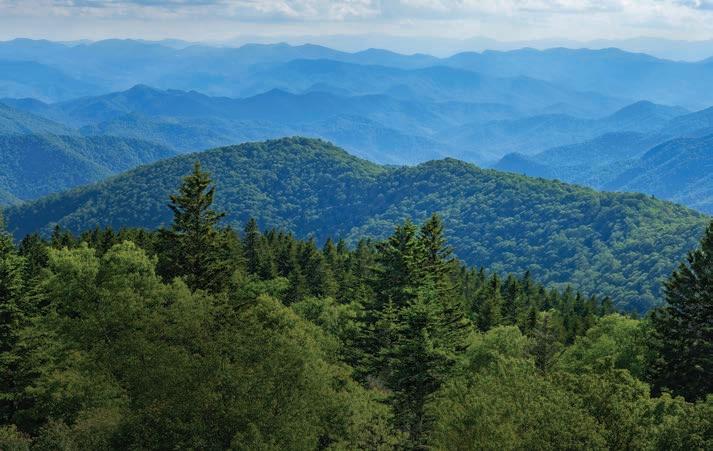



The Richmond® Hybrid Electric Heat Pump Water Heater is the most efficient water heater available. It’s full of smart features you will love—from built-in Wi-Fi to multiple operating modes that save energy and protect the planet. Learn More at RichmondWaterHeaters.com/Hybrid



them to shut down, will not solve the problem.
In a letter to the EPA, Wisconsin Electric Cooperative Association President and CEO Steve Freese said, “WECA believes the proposed rules contain timelines that are unrealistic and unachievable. The compliance deadlines endanger new and existing natural gas plants and all but ensure coal units will shut down. It is unlikely that
more than 80% of generation on high-demand days.
With the adoption of more electric vehicles (a separate EPA rule restricts emissions in transportation, prompting 60% of all new cars to be electric by 2030) and electrification incentives for home heating and appliances, demand will continue to grow, Burt said, widening the risk of an electricity shortfall. In a risk assessment, NERC rated the MISO region as “orange” or “elevated risk” for this summer.
“Up until three years ago, we didn’t even do color-coded charts, because nothing was ever orange. And this winter is going to be red,” Burt said. “It’s meant to be a wake-up call.”
NERC writes the reliability standards that could prevent power plant operators from shutting a plant down in the interest of preventing rolling blackouts, which could put plant operators at odds with the EPA if the new rule takes effect.
the infrastructure could be put in place due to the Wisconsin Public Service Commission’s permitting process, cost, supply-chain challenges, public opposition, and land ownership/access. WECA believes the proposed rules threaten baseload electricity production, reliability, and affordability.”
Reliability may be the biggest threat of the three. The historically fuel-agnostic North American Electric Reliability Corp. (NERC), which develops and mandates reliability standards for the grid to prevent large-scale outages and catastrophic collapse, and the Midcontinent Independent System Operator (MISO), which directs the supply of electricity for 15 states including Wisconsin and part of Canada, have both recently broken with tradition and warned of the growing risk of blackouts if baseload power plants continue to be retired without adequate replacement.
“We’ve got less generation in this country today than we did 10 years ago,” Richard Burt of NERC’s Midwest Reliability Organization recently told electric cooperative industry leaders at WECA’s Energy Issues Summit. Burt said as more coal plants are retired and replaced with intermittent renewables such as wind and solar, the risk of an energy shortfall grows, and noted that even with all the new solar installations, solar generation increased from 1.7% in 2012 to 3% in 2022. The bulk of generation, about 60% nationally, still comes from coal and natural gas. In the MISO region, coal and natural gas provide
The Edison Electric Institute, which represents investor-owned utilities, also argued against the rule due to the technical shortcomings of clean hydrogen and carbon capture.
Meanwhile, the EPA acknowledges that since 2005, the power sector has reduced carbon dioxide emissions 36 percent despite the increased production to meet growing demand.
Those who provide wholesale energy to Wisconsin electric co-ops, including Dairyland Power Cooperative, Great River Energy, Alliant Energy, We Energies, and Minnesota Power, have set goals aimed at reducing emissions.
“From deploying microgrids and renewables to launching demand response programs, electric cooperatives take an innovative and diverse approach as they work towards a responsible energy future,” NRECA’s Matheson said.
The EPA proposal will not be final until at least next year, and even then, it may end up before the U.S. Supreme Court, which just last summer rejected the EPA’s previous attempt to put state-level caps on carbon emissions.
“Everybody understands that ultimately we want to reduce carbon and add more renewables, and we’re going to get there, but it has to be at a controlled pace,” Dairyland’s Foss said. “The last thing we want to do is use unproven technology and put our ability to provide affordable and reliable energy to our members at risk.”
Especially when it’s really hot.—Julie Lund
“Up until three years ago, we didn’t even do color-coded charts, because nothing was ever orange. And this winter is going to be red,” Burt said. “It’s meant to be a wake-up call.”
A: Upgrading or improving your windows is an important component of your home’s energy efficiency. According to the Department of Energy, heat gain and loss through windows consumes 25% to 30% of residential heating and cooling energy use.
Start by identifying the kind of windows you have. Are they single pane or double pane? Looking closely at the window’s edge, you can see the number of windowpanes. Are the frames metal, wood, or vinyl? Some manufacturers etch the make and model numbers in a corner of the glass, so you can look up the manufacturer for more information.
Single-pane windows and double-pane windows with metal frames are the least energy efficient. The lower the efficiency of your existing windows, the higher the potential for energy savings.

There are several options for improving your windows, ranging from replacement windows to storm windows to budget-friendly repairs.

Window E ciency Several components can make windows more efficient. High-quality frame materials insulate and reduce heat transfer. Two or more panes of glass with space in between (filled with air or gas) improve the window’s
insulation capability. Warm edge spacers hold the panes of glass the proper distance apart and help insulate the edges of the panes. Low-emissivity coatings applied to the glass can reflect infrared light, keeping the heat in during the winter and out during the summer.
Window efficiency is rated in U-factor and Solar Heat Gain Coefficient, or SHGC. U-factor measures heat transfer through the window, which relates to how well it insulates. The lower the U-factor, the more efficient the window. The SHGC measures how effectively the window blocks heat from the sun.
If you want to replace your existing windows, I recommend shopping for ENERGY STAR®-certified windows.
ENERGY STAR® sets specific U-factor and SHGC requirements based on your geography, so you get the best fit for your location. Replacement windows offer additional benefits, like improved operability and aesthetics. As with many industries, the window industry has been impacted by price increases over the past few years, so keep in mind, this can be an expensive upgrade.
Storm windows are a lowercost solution for some homes.
Before looking into window replacement, assess the condition of your existing windows for opportunities to improve their e ciency.
Maintain your existing windows by ensuring the sashes lock properly, adding caulk around the trim, and replacing worn weatherstripping.
Traditional storm windows are made with clear glass. Lowemissivity storm windows have energy savings similar to replacement windows at about a third of the cost.
Storm windows are mounted to the interior or exterior and are available in operable styles, so you can still open and close your windows. Look for ENERGY STAR®-certified models.
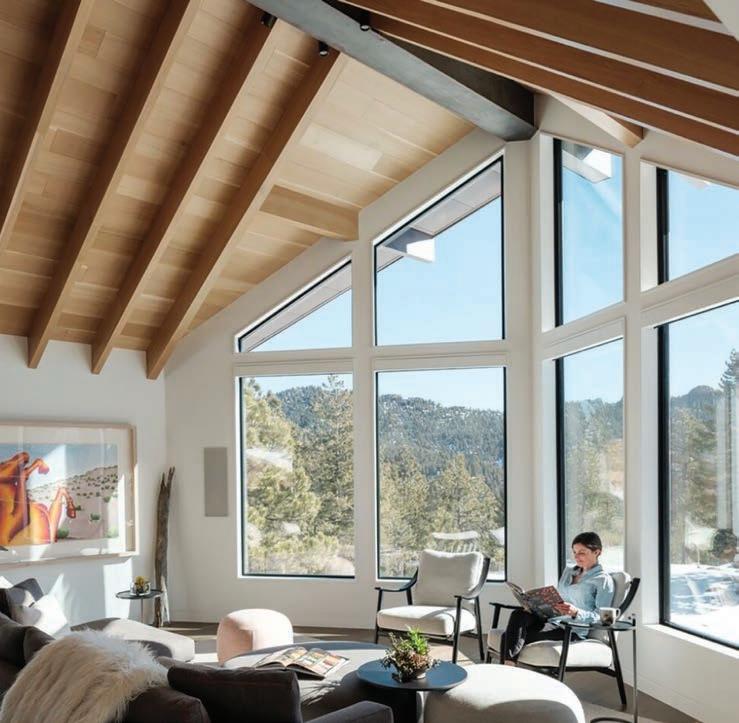
If you want to maintain the historic architecture of your existing windows, low-emissivity storm windows are a great option. Some companies can refit your existing window frames with custom double-pane glass and weatherstripping.
As with any home improvement project, be sure to get multiple quotes to compare pricing and scope of work. You may find additional savings with rebates from your electric co-op, or state or federal tax credits for window upgrades.
If new windows or storm windows are not in the budget, your best bet is to maintain your existing windows. Keep the paint and caulking on the exterior in good condition. That will help prevent damage from the elements. Caulk around the inside trim, and ensure sash locks are installed properly and seal tight when locked. There are a variety of weatherstripping types for windows to keep drafts at bay.
Whether you replace or make improvements to what you have, adding efficiency to your windows will add year-round comfort to your home.
Miranda Boutelle writes on energy efficiency topics for the National Rural Electric Cooperative Association, the national trade association representing more than 900 electric co-ops.
Windows add to the aesthetic of our homes. Ensure they also add comfort year-round by maintaining or replacing old windows.
Photo courtesy of Alpen High Performance Products
Two or more panes of glass improve the insulation capability of the window.

Photo courtesy of Alpen High Performance Products
When checking your windows, ensure sash locks are installed properly and sealed tight when locked.
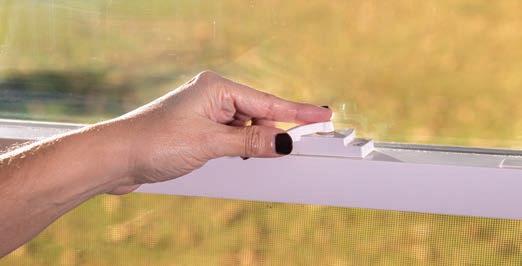













































































































































































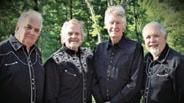














































Know a member who would be great for a member spotlight? Email tskibba@ecec.com.

The Wehlings have deep roots in farming. With a family history of farming that goes back 150 years, Adam Wehling and his wife, Katie, knew that they wanted to carry on this tradition and move to the county to raise their family. After three years of negotiations, they finally purchased a farm just north of Mondovi in 2012 and Cedar Bee Farms was born. The farmer they purchased from was a retired teacher from Mondovi. He had lived on the farm for 70 years. It was an older farm and needed a lot of TLC that the Wehlings were enthusiastic about taking on. Today, Cedar Bee Farms is home to two hives of honeybees, 52 acres of wildflowers, a herd of six grass-fed beef, 500 free-range chickens, and 20 pasture-raised pigs. Their first summer they started raising chickens as a favor to a friend. Shortly after they added pigs and honeybees, and eventually cows. Adam grew up on a dairy farm, and his family only raised dairy steers. All of the animals the Wehlings raise and the products they produce were a learning experience. They did a lot of research and talked to many experienced farmers. They learned about the many ways the local farmers sell their products to the public and decided that direct
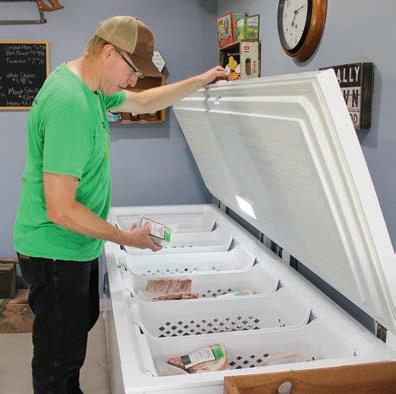


farm sales and grocery store sales were the best options for Cedar Bee Farms. They have a wide range of products, from fresh honey to specialty sausages, brats, and other pork, chicken, and beef products. All their products can be purchased by appointment directly from the farm or at Festival Foods in Eau Claire and Menomonie Market in Eau Claire and Menomonie.
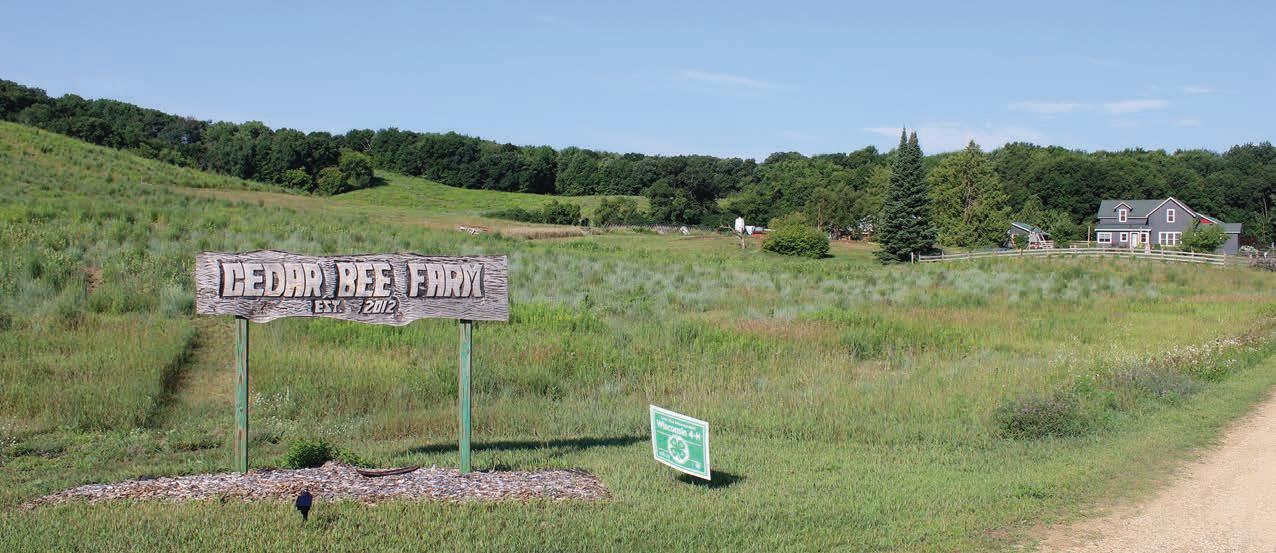
You may know Adam as the dean of agriculture, energy, construction, and transportation at Chippewa Valley Technical College. Adam says that running Cedar Bee Farms efficiently is similar to running his programs at the college, just on a smaller scale. The knowledge he has gained from his job at CVTC helps him in his business at Cedar Bee Farms and vice versa.
Adam is part of ECEC’s Member
Advisory Council. He has been a member of Eau Claire Energy Cooperative for 11 years and a member of Member Advisory Council (MAC) for almost 10 years. Being a part of MAC allows Adam to give input on current programs and services offered by ECEC based on how they work for his family and business. Member Advisory Council members also have a part in determining the future of Eau Claire Energy Cooperative. ECEC is here to serve members. Input from members, such as Cedar Bee Farms, is so valuable to who we are as a cooperative.
Interested in joining Member Advisory Council? Visit https://www.ecec.com/ community/member_ advisory_council for more information.


Eau Claire Energy Cooperative does our very best to keep our members informed. Every so often we will need to contact you whether it is about a billing question or because of routine maintenance happening in your area. Please check your statement to ensure that the telephone number we have on file is correct. Any phone numbers we have will be listed on the tear-off portion on the bottom of your bill. If this phone number is not correct, please log in to your SmartHub app to change it or contact our office at 715-832-1603. You can also view and pay your bills online with the SmartHub App!



You can manage your account right from your smartphone or tablet with SmartHub. Make payments, notify member service of account and service issues, check your usage and communicate directly all at the touch of a button. Download the FREE mobile or tablet app in the Apple App Store or Adroid Marketplace.







The easiest way to pay your bill is in the SmartHub App, although you can pay through SmartHub web, as well. Pay with debit/credit or E-check. It’s fast, it’s easy and the payment applies to your account immediately.
See your daily electric use on SmartHub through the purple button on our website or through the SmartHub App. Why wait to see your bill and THEN make changes? See your daily use and make changes RIGHT AWAY to lower your next bill.



If you would like to have your payment drafted from your checking/savings account or credit card every month, sign up for the Auto-Pay program on SmartHub.
Saturday, October 7, 2023 • 1–4 p.m.

Join us for a sweet treat at cooperative headquarters for our Member Appreciation Event! We’re celebrating YOU, our amazing members, with a delightful afternoon lled with co ee, pie, and ice cream. This event is our way of saying THANK YOU for being a part of our incredible cooperative. Your support, engagement, and positivity are what make ECEC so great. Join us on October 7 for heaps of fun and, of course, loads of pie and ice cream!

Eau Claire Energy Cooperative is a longtime, proud supporter of the Eau Claire County Fair and the Eau Claire County Livestock Auction. Representatives from the ECEC Board of Directors attend the auction each year and bid on various livestock. This year, Andy Bourget and Frank Neibauer participated and purchased an animal raised by Emily Boone. Congratulations, Emily!
Obrycki, President CEO
Non-emergencies: 715-832-1603
Emergencies & outages: Toll FREE 800-927-5090


24 hours a day, 7 days a week
Diggers Hotline: 811 or 1-800-242-8511
Call 3 working days before you dig.
The striking artwork on this distinctive hoodie with a patriotic air will have any outdoor enthusiast stand out everywhere they go. Crafted in a black easy-care cotton blend knit, the back of the hoodie showcases artwork featuring a magni cent deer against a distressed American ag. An appliqué patch of a stylized American ag with embroidered edges adds to the patriotic style on the front. Custom details include a comfortable brushed eece interior, a brown thermal knit lined hood, kangaroo pockets, knit cuffs and hem, a full front zipper, and silver-toned metal tippets on the hood drawstrings. Imported.





Available in 5 men’s sizes M-XXXL, this handsome hoodie is a remarkable value at just $99.95* (for sizes XXL and XXXL, add $10), payable in 3 easy installments of $33.32, and backed by our 30-day money-back guarantee. This is a limited-time offer, so don’t delay. To acquire yours, send no money now; just return the Priority Reservation today!
YES. Please reserve the “Free to Roam” Men’s Hoodie as described in this announcement in the size indicated below. ❑ XXL (50-52) 01- 40872-014 ❑ XXXL (54-56) 01- 40872-015 ❑ Medium (38-40) 01- 40872-011 ❑
(42-44) 01- 40872-012










and photo courtesy of the National Honey Board.

1 medium eggplant, cut into slices 1/2-inch thick
2 tsp kosher salt
4 cloves garlic, peeled and chopped
4 Tbsp olive oil, divided
1 prepared focaccia or atbread
2 cloves garlic, minced
1 cup shredded smoked mozzarella, divided
3 Tbsp honey

1/3 cup balsamic vinegar
1 Tbsp fresh rosemary, chopped
1 tsp freshly ground pepper
1/4 cup Kalamata olives, pits removed and chopped
1/2 cup whole milk ricotta cheese
1 cup cherry tomatoes, halved
Fresh basil for garnish
Preheat oven to 400 degrees. Sprinkle the eggplant slices with salt and let them sit for 15 minutes. Place the 4 chopped garlic cloves in some aluminum foil and 1 tablespoon olive oil to cover; twist up to make a bundle. Place on a sheet pan and put the oven. Brush the focaccia with 2 tablespoons of the olive oil and the 2 minced garlic cloves, and sprinkle half of the mozzarella evenly over the surface. Bake for 5 minutes until cheese is just melted, remove from the oven, and let cool. Pat the eggplant dry and brush with 1 tablespoon of olive oil. Roast the eggplant on sheet pan alongside the garlic packet in the oven. After 10 minutes, remove the eggplant from the oven to cool. Leave the garlic packet in the oven to continue roasting. Combine the honey and balsamic vinegar in a small saucepan and cook on medium-low until reduced and syrupy, approx. 15–20 minutes. Whisk in the fresh rosemary and ground pepper, and set aside to cool. Remove the garlic from the oven and smash up the softened garlic and olive oil in the packet with a fork, spread onto the focaccia. Layer the eggplant and olives evenly across the surface, top with dollops of ricotta and the remaining mozzarella. Return the focaccia to the oven for another 6–8 minutes. Sprinkle the tomatoes and basil across the focaccia and drizzle with the honey balsamic glaze to serve. Serves 4–6. Notes: Italian sausage would be a great addition to this dish.
Recipe and photo courtesy of the National Chicken Council.
3 Tbsp olive oil, divided
1-1/2 to 2 lbs chicken leg quarters
1 tsp salt, divided
1 tsp freshly ground black pepper, divided
1 small eggplant, cut into 1/2-inch dice
1 medium zucchini, cut into 1/2-inch dice
1 small onion, diced
2 cloves garlic, minced
1/4 cup white wine or water
1 (14.5 oz) can diced tomatoes with juices
1/4 cup pimento-stuffed green olives, roughly chopped
2 Tbsp capers, rinsed
2 Tbsp red wine vinegar
1 tsp sugar
2 Tbsp parsley, minced
In a large skillet over medium high-heat, warm 2 tablespoons olive oil. Season leg quarters with 1/2 teaspoon salt and 1/2 teaspoon black pepper. Add leg quarters to the pan, skin-side down. Brown chicken, turning once, 8–10 minutes per side. Remove chicken to a plate and drain off all but 2 tablespoons oil. Add eggplant to hot pan and cook, stirring, 5 minutes. Add remaining tablespoon of olive oil, along with zucchini, onion, and garlic. Cook 5 minutes, stirring occasionally. Raise heat to high and add white wine or water to pan, stirring to scrape up any browned bits. Add remaining ingredients except parsley and place chicken legs in mixture. Bring to boil, reduce heat to medium-low, cover, and simmer for approx. 35–40 minutes or until chicken is cooked through or until an instant read thermometer reads 170 degrees. To serve, place some of the eggplant ragout onto plates, top with a leg quarter, and sprinkle with parsley. Serves 4.

Recipe and photo courtesy of the National Turkey Federation.
1 lb Italian turkey sausage, cut into 1-inch pieces
1 medium eggplant, cut into 1/2-inch cubes
4 cups prepared chunky vegetable spaghetti sauce
12 oz penne pasta, cooked according to package directions and drained
4 oz Asiago cheese, grated
In a large, heavy nonstick skillet over medium heat, sauté turkey sausage and eggplant for 12–15 minutes or until sausage is no longer pink and eggplant is soft and lightly browned. Add spaghetti sauce to turkey mixture and simmer

3 minutes or until heated throughout. To serve, spoon sauce over drained penne and top with Asiago cheese. Serves 6.

Recipe and photo courtesy of the National Honey Board.
1 small eggplant, cut into 1/2-inch dice
2 tsp salt
1/4 cup olive oil
2 Tbsp balsamic vinegar
1-1/2 Tbsp honey
2 tsp fresh oregano, chopped
2 tsp fresh thyme, chopped
2 tsp fresh rosemary, chopped
1 tsp kosher salt
1/2 tsp crushed red pepper
6 Roma tomatoes, cut into 1/2-inch dice
2 shallots, peeled and thinly sliced
8 oz fettuccini or other long pasta
2 Tbsp kosher salt for pasta water
1/3 cup grated parmesan
2 Tbsp olive oil, optional
1/2 cup fresh flat leaf parsley, chopped
Preheat oven to 400 degrees. In a large bowl, sprinkle the eggplant cubes with the salt and set aside to drain for 10 minutes. Drain any liquid off the eggplant and pat dry with paper towels. In a small bowl, combine the olive oil, balsamic vinegar, honey, oregano, thyme, rosemary, 1 teaspoon kosher salt, and crushed red pepper. Toss the eggplant with half of the olive oil mixture and spread out on a sheet pan. To the same bowl add the rest of the olive oil mixture to the tomatoes and shallots; toss to combine. Spread the tomato and shallot mixture on a second sheet pan and place both pans in the oven to roast for 10–15 minutes or until eggplant and tomatoes begin to soften and caramelize. The eggplant may take a few more minutes than the tomatoes. Remove from the oven and set aside. While the vegetables are roasting, bring a large pot of salted water to boil, add the pasta and stir to break it up. Cook until pasta is al dente (firm, but not crunchy), 8–10 minutes. With a soup ladle or heatproof cup, dip out 1 cup of the pasta water before draining the pasta. Do not rinse the pasta. Return the pasta to the pot after draining and add the eggplant and tomato mixture. Turn the heat on low and toss to combine along with the parmesan and enough of the pasta water to help loosen and coat the pasta. You may add additional olive oil at this point if you wish. Toss with the parsley and serve. Serves 2–4.
RECIPE COURTESY OF KAREN VICK, ONALASKA
5-1/2 lbs apples, peeled and nely chopped
4 cups sugar, depending on sweetness of apples
2–3 tsp ground cinnamon
1/4 tsp cloves
1/4 tsp salt
Place apples into a slow cooker with sugar, spices, and salt. Cover and cook on HIGH for 1 hour. Reduce heat to LOW, cook 9–11 hours until thickened, stirring occasionally. Spoon into freezer containers, leaving one-half inch of headspace. Cover, refrigerate, or freeze. Makes 4 pints.
‘MY FAVORITE RECIPE’
RECIPE COURTESY OF KAREN VICK, ONALASKA
REQUESTS FROM OUR READERS
Deanne Sczepanski, Whitehall, is still looking for Chicken in a Biscuit Casserole, using the crackers of the same name.
SEND TO: WECN, Reader Recipes, 222 West Washington Ave., Suite 680, Madison, WI 53703-2719 or jennifer@weca.coop
6 lbs apples, peeled and nely chopped
1 cup apple cider
2-1/2 cups sugar
2 tsp ground cinnamon
1/8 tsp cloves
Pinch of salt
Prepare apples and put into a large pot; cover with cider, sugar, spices, and salt. Cover and cook over low heat for 1-1/2 hours, stirring occasionally. Spoon into jars, cover, and refrigerate. Makes 4 pints.
RECIPE COURTESY OF RUTHANN MARTIN, WITHEE
2 eggs, separated, yolks beaten
2 Tbsp our
1/2 tsp salt
1/4 tsp pepper
2 cups corn kernels
Vegetable oil for frying
Add beaten egg yolks, our, and seasonings to corn. Beat egg whites until sti peaks are formed and fold into the corn mixture. Drop from a spoon into a frying pan with hot oil. Cook until well-browned on the bottom. Carefully turn and brown both sides. Serve hot with syrup or gravy.
Submit your favorite recipes to be featured on our reader recipe page. Email to jennifer@weca.coop or submit directly at http://wecnmagazine.com/submit-a-recipe/. Due to food safety issues, we cannot accept canning recipes.
RECIPE COURTESY OF GEORGE STONE, COLFAX
SPICE MIX
1 tsp salt
1 tsp paprika
1/2 tsp garlic powder
1/2 tsp onion powder
1/2 tsp basil
1/2 tsp thyme
1/4 tsp black pepper
1/4 tsp white pepper
1/4 tsp red pepper
Combine seasonings together for spice mix.
FISH
1-1/2 lbs sh llets of choice
3 Tbsp butter
Dried parsley, to taste
Pat sh llets dry and sprinkle with spice mix evenly on both sides. Melt butter in a shallow baking dish and sprinkle with parsley. Arrange lets in a single layer and broil on top rack until sh akes with a fork.
RECIPE COURTESY OF GEORGE STONE, COLFAX
1-1/2 lbs sh llets of choice
1 tsp salt
1/2 tsp black pepper
1 medium onion, sliced
1/2 green pepper, chopped
1 (4 oz) can mushrooms, drained (or fresh)
3 Tbsp butter
1 (16 oz) can tomatoes, drained
1/2 tsp paprika
1/4 tsp red pepper
3–4 dashes hot sauce of choice (or to taste)
Pat sh llets dry, sprinkle with salt and pepper on both sides, and arrange in a greased, shallow baking dish. In a skillet, cook onions, peppers, and mushrooms in butter. Add tomatoes, spices, and hot sauce, and bring to a simmer. Adjust seasonings if necessary. Pour over sh and bake in a 375-degree oven until sh akes with a fork.
These sunny fall days are the perfect time to prepare your home for the cold weather that’s just ahead. Here are a few simple steps you can take now that will help your energy bill later.
Check your attic to see that is has adequate insulation. Insulation is rated in terms of its thermal resistance, or R-value. The higher the R value, the greater the insulating e ectiveness.













Even though the weather is colder, your ceiling fans can still be a great help in keeping your home comfortable. Change their direction to clockwise to redirect warm air downward. Just remember to turn them o in empty rooms.
Hot baths and showers are inviting on chilly days, but heating water uses a lot of energy. In fact, water heating is the second largest energy expense in your home. Cut down on your hot water use by installing low- ow showerheads and replacing faucet aerators with lowow options.

As the weather gets colder you’re going to be spending more time inside, using lights and electronics. Make sure all of your home’s light xtures are out tted with LED bulbs, which last last 25 times longer than incandescent bulbs. Plug home electronics into power strips and turn them o when not in use.
Move furniture pieces away from vents and heat registers so they don’t block the ow of heat into the house. While you’re at it, switch out your curtains with heavier drapes to help block the cold coming through the window. Just remember to your open your curtains on sunny afternoons to let the sun warm up your room.






Reduce air leaks through windows and doors with caulk or weatherstripping. Caulk is generally used to seal any cracks and openings between stationary house components such as windows and door frames, and weatherstripping is typically used to seal components that move, such as doors and operational windows.
Source: energy.gov
If you’re yearning for a home where the buffalo roam, central Wisconsin is not likely the place you have in mind. Indeed, you won’t see true wild buffalo here— those animals are actually native to Africa and Asia. But Brewster Higley likely had North American bison in mind when he penned the words to that treasured old Western tune, and you can see wild bison at Sandhill Wildlife Area in Babcock. You can also see deer, coyotes, a wide range of small mammals and amphibians, and an abundance of birds including the tall and graceful Sandhill cranes for which the area is known.
Located on Oakdale Electric Cooperative’s lines, Sandhill Wildlife Area is one of three managed State Wildlife Areas that comprise the Sandhill-Meadow Valley Work Unit, which covers a total of 90,000 acres of state-managed public land. Sandhill contributes 9,634 acres to that total, 9,150 of which are enclosed within a deer-proof fence.
“Sandhill is pretty unique because of that fence,” said Quinn Brownell, natural resources educator for Sandhill Wildlife Area. He explained that the contained acreage is an ideal space for the various conservation and wildlife research projects and demonstrations that are ongoing at Sandhill.
However, the fence is meant to help manage the wildlife within—not to keep the public out.
“A lot of people don’t realize that we are a public facility. The fence can look a bit intimidating, but people can just come through the gate at the entrance. Anyone can come into the property,” Brownell said, adding that the area is not a state park and is therefore free to enter.
Sandhill is open daily and mostly accessible yearround, weather permitting. There’s something different to see and experience in every season, but autumn brings an especially unique opportunity. As waterfowl begin to



prepare for their winter migration, the wetland areas within Sandhill become particularly active.

Brownell explained for about two to three weeks in the fall— typically mid to late October is the peak time—Sandhill cranes are busy foraging in the surrounding fields to prepare for their migration south for the winter. They forage during the day and swoop back down to the wetlands at dusk to roost before taking off the next morning in search of more food. An observation tower overlooking Gallagher Marsh within the Sandhill fence offers a stunning view of the cranes’ activity.
“This is when we do our crane surveys,” Brownell said. “Last year we counted 3,000 Sandhill cranes in one night, and that was actually a low number. Our average count is somewhere between 4,000 and 5,000. I would encourage anyone to come to the property in the fall, before the Trumpeter Trail closes, and come at dusk. All the Sandhill cranes you’ll see is really something.”
Sandhill Wildlife Area’s backstory is also something special. Located within the sandy bed of a glacial lake, the area is defined by swaths of wetlands
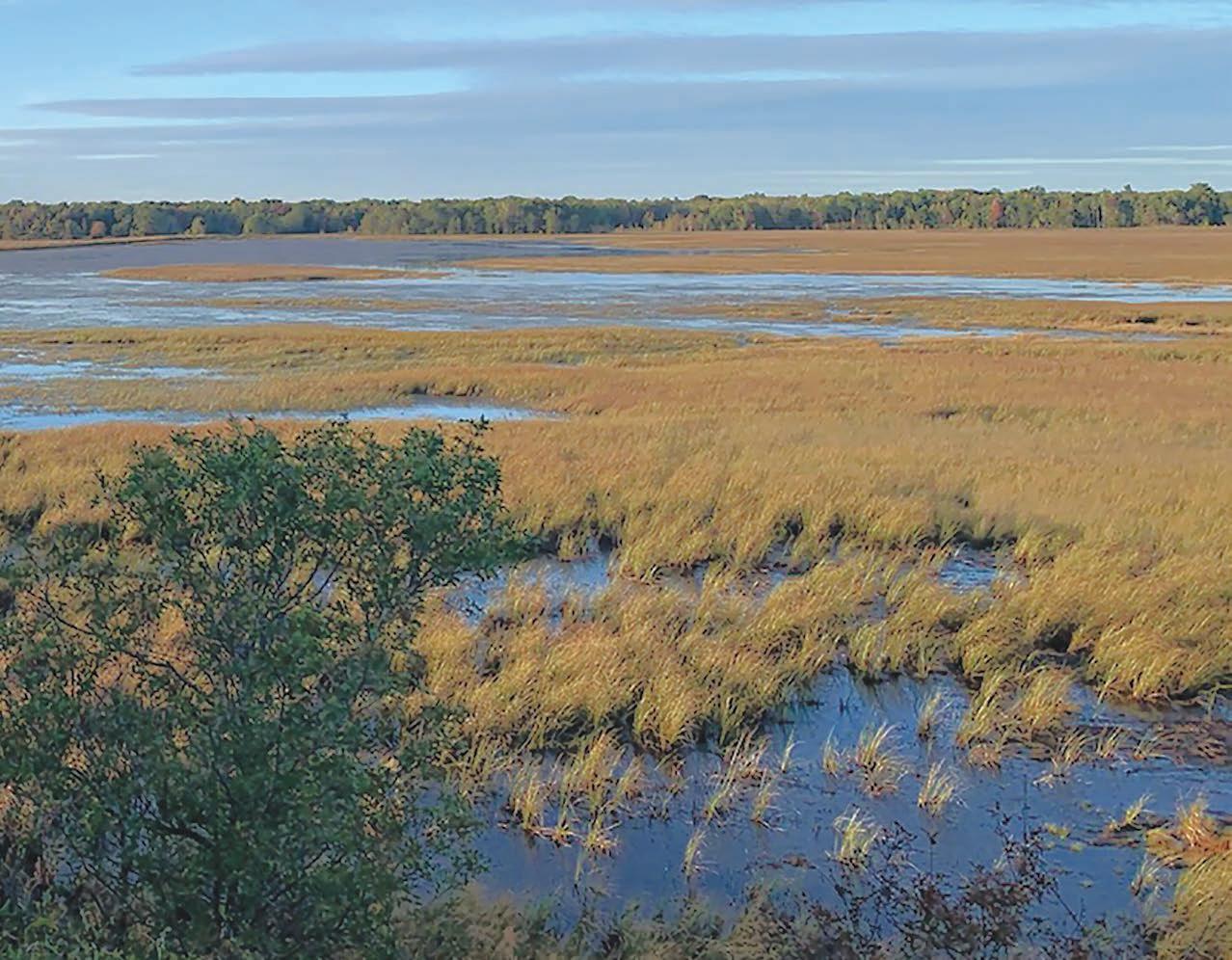
interspersed with pockets of wooded uplands. In the 1900s, farmers dug drainage ditches in hopes of coaxing out some cropland from the marshy terrain, disrupting much of the native wildlife.
A combination of factors, including high drainage taxes and the Great Depression, eventually drove many of the farmers from the depleted land. In the 1930s, a biologist named Wallace
Grange and his wife, Hazel, purchased 9,460 acres of this abandoned, tax-delinquent land, enclosed much of it within an 8-foot deer-proof fence, and established the Sandhill Game Farm.

A contemporary of Aldo Leopold, Grange employed multiple conservation measures on the property, restoring the wetlands and managing the habitat to boost the native wildlife. He shipped deer and grouse to other parts of the country where their populations had been depleted. The couple sold the property to the State of Wisconsin in 1962, specifying that it be used as a wildlife demonstration area.
The Granges’ presence can be felt throughout Sandhill today. The conservation measures they practiced and that the State of Wisconsin has built on over the years have resulted in a diverse landscape that supports a huge variety of wildlife, including many threatened and endangered species that depend on Sandhill’s carefully managed habitat.
The wooden deer fence the Granges installed has long since been updated, but it follows the same border that the couple established. The little cabin on the marsh edge where Wallace and Hazel wrote three conservation-themed books between them is still there, accessible by Sandhill’s newest hiking trail—the Wallace Grange Interpretive Trail. Interpretive displays along this trail and elsewhere along the property tell the Granges’ story.
Even the bison herd—a visitors’ favorite—is genetically linked to the original herd the Granges brought here. Today’s herd is kept to a manageable size of about 15 bison that roam freely in their own 260-acre enclosed pasture. An observation tour along pathway in front of the bison enclosure makes it easier for visitors to spot them.
The public can experience Sandhill Wildlife Area in several different ways. A unique recreational feature of Sandhill is the Trumpeter Trail Auto Tour, a 14mile, one-way vehicle route that winds through the fenced-in property. A kiosk at the entrance gate offers maps and brochures explaining the various natural features inside the fence; visitors need only to self-register at the kiosk, open the gate and close it behind them once they’ve entered, and then enjoy a peaceful, scenic drive along the wellmarked auto path.

Interpretive signs along the Trumpeter Trail help visitors understand what they’re seeing, and there are places along the route to park the car and hop out for a closer look, a snack break at one of the occasional picnic areas, a walk along one of the five hiking trails that can be accessed along the Trumpeter Trail, or a climb up one of the two observation towers for a bird’s-eye view of either the bison pasture or the Gallagher Marsh. The Trumpeter Trail is open to vehicle traffic daily, generally from sunrise to sunset, spring through fall, weather permitting.
Those who choose to explore Sandhill by foot or bicycle can enter through one of two walk-in gates, including one at the entrance by the kiosk. These gates are open all year, allowing for snowshoeing or cross-country skiing during the winter, although trails are not groomed in the winter.
Waterfowl, upland bird, and small game hunting is also allowed within the fence according to specific Sandhill Wildlife Area regulations that closely align—but are not identical to—state hunting regulations. Daily permits are required for hunting.
In addition, guests can explore the Sandhill property by way of one of the many group activities that are open to the public. Sandhill has an Outdoor Skills Center where it hosts a variety of workshops throughout the year. Educational activities are sponsored and supported by Friends of Sandhill, a nonprofit organization dedicated to supporting
A unique recreational feature of Sandhill is the Trumpeter Trail Auto Tour, a 14-mile, one-way vehicle route that winds through the fenced-in property.
Top row, left: An observation deck overlooking the bison pen makes it easier to spot them. Bison once lived in this area but were extirpated in the 1830s. Wallace and Hazel Grange brought bison to the game farm they established here; some of these bison are descendants of the Granges’ original herd.
Top row, middle: Sandhill cranes are abundant in the marshes of Sandhill Wildlife Area. Fall is an especially good time to spot them as they prepare to migrate.

Above left: Sandhill’s newest hiking trail is the Wallace Grange Interpretive Trail, which leads to the cabin along a marsh edge where Wallace and Hazel Grange wrote their conservation-themed books.


Above, center: A unique amenity of the Sandhill Wildlife Area is the Trumpeter Trail, a 14-mile, self-guided auto tour through the fenced-in area. The Trumpeter Trail is open spring through fall, weather permitting.
Right: Sandhill Wildlife Area includes a number of marshes, but there are wooded uplands as well. The North Blu Trail is thick with hardwoods and includes steps to a high point that rises 200 feet above the surrounding land.


wildlife education at Sandhill.
The wide range of program topics includes learning to hunt, foraging for wild edibles, wild game cooking, wilderness first aid, and holiday wreath-making. Other activities include a candlelight hike in the winter, a summer bike tour, and the popular October crane watch. Registration is
required for all programs, and a fee may be required for any materials. However you choose to experience it, Sandhill Wildlife Area offers a peaceful escape from the commotion of modern life. A visit here is likely to satisfy that longing for a home where (apologies to Brewster Higley) the bison roam.—Mary Erickson
Sandhill Wildlife Area is located at 1715 County Hwy X, Babcock, WI 54413. Entrance is free but donations are appreciated. For more information, visit dnr.wisconsin.gov/topic/Lands/ WildlifeAreas/sandhill or call 715-8842437. For more information about a class, or to register for a class, call 715-884-6335.
WANTED: Paying cash for WWII ags, daggers, swords, guns, etc. Also, lever-action ri es. 715-340-1974.
WANTED: OLD BEER CANS AND BOTTLES. Let me know what you have. 715-8289414 Willing to travel. Paying cash.
WANTED: DEER TAGS, BACK TAGS. Trapping, bear, hunting licenses. Otter, sher, bobcat tags, party permits, old traps. 715255-9284 David Schober, W4234 Rock Creek Rd., Loyal, WI 54446.
FOR SALE: RACING HISTORY BOOKS. Hales Corners, Beaver Dam, Cedarburg, Slinger Super Speedway. $15 each plus mailing. Dave 414-430-3183.
CHAINSAWS WANTED DEAD OR ALIVE. Buying 1 or 100 McCulloch, Pioneer, Jonsereds, Echo, STIHL, Homelite, Remington, Mall. Buying all brands and sizes. Non-running, running, siezed, parts. Let me know what you have - will travel. Call Chainsaw Mike at 715-828-9414.
OLD MOVIES TO DVD / FD - Pro transferring 8mm, VHS, slides, audio, and all formats. Saving memories! DVD Productions Gene 715-827-2302.
COLLECTOR LOOKING FOR ANTIQUE OR HAND-MADE LARGE TRAPS. 715563-6658 For sale: smaller trapping traps, lever-action ri es from 1800’s.
E-BIKES FOR SALE: Let me get you on the right e-bike. Recycle Bike Shop Mobile, Boyceville, WI. Call or text Bicycle Larry 715-702-1452.
FOR SALE: WOOD, SIDING, AND BEAMS FROM BARN. Also doors in excellent condition. Also steel roof sheets. Questions, call 608-762-5783.
K&P ORCHARD: HONEYCRISP + 4 VARIETIES. Mid-September through October. Call Mark Kaufman 715-533-4379; W203 Colby Factory Rd, Colby, WI 54421. Check us out on Facebook.
BEAVER TRAPS FOR SALE. Also, muskrat, mink, and fox traps. Stretchers for all of them. 715-563-6658
FOR SALE: 20 FT CARGO CONTAINER. Wind & water-tight, excellent condition, railroad container red, Viroqua, WI area. $2,800. 651-604-7226.
MCKAY NURSERY COMPANY - Wisconsin
Grown Since 1897. Provider of quality shade & ornamental trees, fruit & owering trees, evergreens, shrubs, perennials, ground cover, and vines. Design services & delivery available. Contact Eric at ezlandscapewi@ gmail.com or call 608-387-4287. “Your McKay Independent Sales & Service Provider.”

Are you considering switching to an electric vehicle (EV)? If so, do those plans include having a charging station installed at your home? Home charging stations are convenient and perfectly safe to use…as long as they’re installed and used properly. Here are a few things to consider:
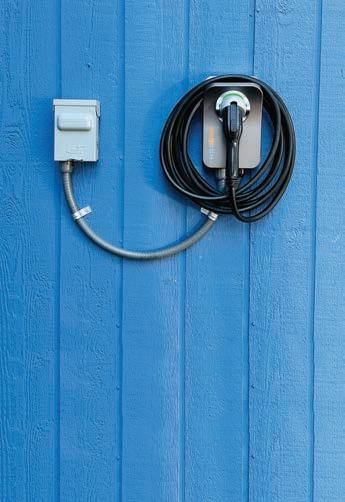
• Check with your electric coop and a licensed electrician before modifying your electrical system or installing a charging station. An electrician will need to make sure your home’s wiring complies with local, state, and national codes.
• Plug Level I EV chargers directly into an outlet designed to handle the amperage of the charging device.
Classi ed ads reach more than 152,000 mailboxes. RATES: For non-members of Wisconsin rural electric co-ops: one insertion, $25 minimum (up to 20 words); additional words, $1.25 each. For members of Wisconsin rural electric co-ops: one insertion, $14 minimum (up to 20 words); additional words, $.70 each. Count name, address, and phone number as part of ad. Please include zip code. FOR PROOF OF MEMBERSHIP, please include your address label from your copy of the magazine. FREQUENCY DISCOUNTS: 2% discount for 3 months; 5% for 6 months; 10% for 12 months. DEADLINE: 1st of the month prior to the month in which the ad is to appear. All classi ed ads must be paid in advance. There is no agency discount on classi eds. Make check or money order payable to: WECA. Mail to: WECN—Classi eds, Attn. Jennifer, 222 W. Washington Ave., Ste. 680, Madison, WI 53703. Ph: 608-467-4638. Email jennifer@weca.coop. We reserve the right to refuse ads.

• If you plan to purchase a Level 2 charging device (these units must be installed by a licensed electrician), make sure to select one that is certi ed by a nationally recognized testing laboratory.
Source: NRECA

Your














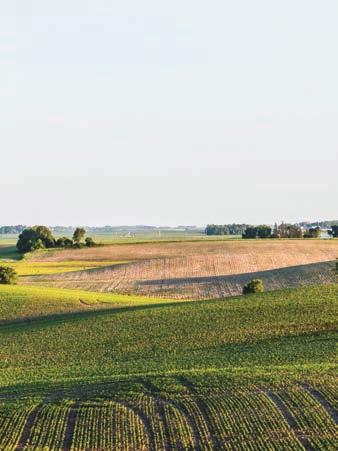

1, 2 Gun Show—Butternut. Area Park, Fri. 4–8 p.m., Sat. 8 a.m.–3 p.m. Admission $5, good both days. Raffles, food, and refreshments. For more 715-769-3921.
1, 2 Little Suamico Days—Little Suamico. 1015 County Road J, Fri. 5–11 p.m., Sat. 10 a.m.–11 p.m. Free admission and parking. Food, beverages, softball tournament, games, live entertainment both nights, fireworks Sat. at dusk, children’s area, fire dept. demo, military recognition ceremony, more. 920-604-8570.
1–3 Butterfly House—Fall Creek. Beaver Creek Reserve, Fri. & Sat. 11 a.m.–3 p.m.; Sun. 12–3 p.m. Admission $5 adult; $3 youth; kids under 2 free. Group tours available. Closed on rainy days.
1–30 Bloomin’ Greenhouse Tour—Clark County. Various locations, all day. Annual self-guided tour of Clark County’s many greenhouses & garden centers. Annuals, perennials, mums, herbs, grasses, trees, shrubs, hostas, daylilies, fairy garden supplies, garden art, home décor, and more! For a brochure, 715-255-9100.
2 Car Cruise—Cassville. Riverside Park, all day. Begin at Piggly Wiggly in Prairie du Chien or Grant County Rest Area 106. Cars leave at 11 a.m. and cruise 90 minutes to Cassville. Food, drinks, burn-out box, pinstripe artist, entertainment for all ages. Band Wire & Nail plays 6–9 p.m.
2 Fall Raffle & Dinner—Gilman. Jump River Community Center, 11 a.m.–1 p.m. Grilled chicken, squash, polish sausage with sauerkraut dinner. Raffle, country store, games, prizes, and polka music.
3 Truck and Tractor Pull—Jump River. Jump River Park, 12–7 p.m. Grilled chicken, hamburgers, fries, and hotdogs; cold drinks available. 715-290-0061.
3 CheezLand Uke Band Jam—La Crosse. Ward Avenue Moose Lodge, 6–8 p.m. Meets every Wednesday. For more info, www.cheezlandukeband.com
8 Donut Fry—Jim Falls. United Methodist Church, 10 a.m.–3 p.m. Advance orders appreciated. 715-382-4735.
8, 9 Yellowstone Art Trail—Cadott, Boyd & the eastern Lake Wissota area of Chippewa Falls. 9 a.m.–5 p.m. both days. Free, self-guided art tour of 31 local artist. Maps available on Facebook.
8–10 1800’s Historic Reenactment—Platteville. Mound View Park & Campground, Fri. 8 a.m.–4 p.m., Sat. 11 a.m.–5 p.m., and Sun. 10 a.m.–3 p.m. Live music, period blacksmiths, woodworkers, military demos, Native American storytelling.
8–10 Dairy Days—Platteville. Legion Park, all day. Flea market, rides, parade, dairy cattle show, arts and crafts fair, food, truck and tractor pulls, live music, more.
8–10 Spoon Gathering—La Farge. Village Park, 9 a.m.–7 p.m. An event for spoon carvers to carve, talk, share techniques and tools, and to trade or sell.
9–10 Laura Ingalls Wilder Days—Pepin. Various locations, Sat. 9 a.m.–8 p.m.; Sun. 7 a.m.–4 p.m. Actor Dean Butler (Almanzo Wilder) from the Little House on the Prairie TV series. www.lauradays.org
9–10 Cornucopia Art Crawl—Cornucopia. Intersection of Main Street and Marina, 1–4 p.m. Featuring local artists. Art, food, and music. 715-742-3464.
10 Car Show and Swap Meet—Holcombe. Lake Holcombe Lions Pavilion, 9 a.m.–2 p.m. Chicken dinner. $10 per show car. Vendors welcome; 715-559-4633.
10 Heritage Sunday—Beloit. Beckman Mill Rock County Park, 11 a.m.–4 p.m. Grinding begins at noon. Blacksmithing, wood carvers, basket weavers, wool spinners, rug weavers. 608-751-1551.
15, 16 Quilt Show—Cochrane and Fountain City. VFW Post 10406 in Cochrane and the Prairie Moon Museum, 3–7 p.m. Items for sale, lunch, drawings, auction.
16 Bucktoberfest—Medford. P-Town Saloon, all day. UTV-ATV poker run, food stand, kid’s games, raffles, beer garden, live music. 715-965-3979.
16 Colton Dixon Concert—Reedsburg. Cal Center at Reedsburg High School, 7–9 p.m. $25–$35. 608-768-8928 ext. 1190.
16, 17 Northern Aged Iron Tractor & Threshing Show—Highbridge. 38565 State Hwy 13; 8 a.m.–5 p.m. Admission is $5; 12 and under are free. 715-274-7807.
17 Polish Dinner & Raffle—Hawkins. St. Mary of Czestochowa, 11 a.m.–1 p.m. Featuring Galumpki, Polish sausage, pork, sauerkraut, parsleyed potatoes.
17 Charcoal Chicken Dinner—Colfax. North Running Valley Luth Church, 12–2 p.m. Charcoal chicken dinner 715-962-3771.
20 Iola Lions/Red Cross Blood Drive—Iola. Iola-Scandinavia Aquatic & Fitness Center, 12–5 p.m.
23 Applefest—Tigerton. Community Park, 7–11:30 a.m. Vendors, petting zoo, music, and food.
23 Sole Burner—Chaseburg. Village Park, 11 a.m.–6 p.m. Food trucks, arts and crafts vendors, live dessert auction, live music, more. 608-452-3367.
23 First People’s Celebration—Argyle. Bob Lafollette Museum, 1–3 p.m. Speakers, philosophy, culture, teachings, values, and land stewardship of the Ho-Chunk people. Vendors, food, and more.
23, 24 Applefest Pancake Breakfast—Gays Mills. Community Center, 7–11:30 a.m. Free will offering. 608-485-2109.
30 Cranberry Harvest Day—Warrens. Wetherby Cranberry Company, 9 a.m.–12 p.m. See cranberries harvested, rent chest waders to wade in the floating cranberries. Admission fee. 608-378-4813.
30 Christmas Tree Festival—Ogema. State Highway 86 and County Road G, 9:30 a.m.–11 p.m. Parade, craft vendors, Christmas trees and wreaths, food trucks, photos with Mr. and Mrs. Claus, more.
Wisconsin Events is a public service for our readers. Due to space limits, we may need to eliminate details, so be sure to include a phone number (with area code) where callers may obtain more info. If we receive more listings than space allows us to print, we reserve the right to select those we believe will be of interest to the greatest number of readers. Please no virtual events. Events can also be mailed to: WECN, Events, 222 W. Washington Ave. Ste. 680, Madison WI 53703-2719
DEADLINE: 1st of the month prior to the month in which the event is to appear.
Send photos of kids with animals, along with a brief description, to WECN Magazine, 222 W. Washington Ave., Suite 680, Madison, WI 53703. Please include the name of your electric co-op. Photos will be returned. If in good-resolution, electronic format, photos may also be uploaded via wecnmagazine. com through the “Submit a photo” tab. By submitting, sender implies that he/she has rights to and owns the image, and grants WECN permission to use the image. By submitting, the parent or legal guardian also authorizes us the right to publish the image.



Occasionally, severe weather can cause power disruptions. When outages occur, our lineworkers get to work! ey restore power as quickly and safety as possible.
Help the lineworker reach the transformer to x the power outage.






Follow Lewis and Clark’s epic 19th-century expedition along the Columbia and Snake Rivers aboard the newest riverboats in the region. Enjoy unique shore excursions, scenic landscapes, and talented onboard experts who bring history to life.

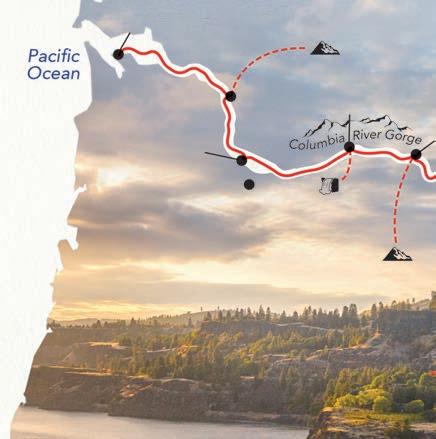
Small Ship Cruising Done Perfectly ®

